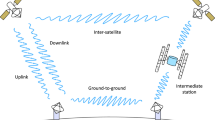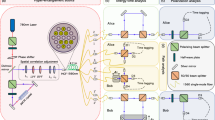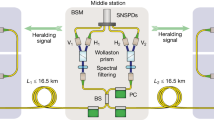Abstract
Quantum entanglement enables tasks not possible in classical physics. Many quantum communication protocols1 require the distribution of entangled states between distant parties. Here, we experimentally demonstrate the successful transmission of an entangled photon pair over a 144 km free-space link. The received entangled states have excellent, noise-limited fidelity, even though they are exposed to extreme attenuation dominated by turbulent atmospheric effects. The total channel loss of 64 dB corresponds to the estimated attenuation regime for a two-photon satellite communication scenario. We confirm that the received two-photon states are still highly entangled by violating the Clauser–Horne–Shimony–Holt inequality by more than five standard deviations. From a fundamental point of view, our results show that the photons are subject to virtually no decoherence during their 0.5-ms-long flight through air, which is encouraging for future worldwide quantum communication scenarios.
This is a preview of subscription content, access via your institution
Access options
Subscribe to this journal
Receive 12 print issues and online access
$259.00 per year
only $21.58 per issue
Buy this article
- Purchase on SpringerLink
- Instant access to full article PDF
Prices may be subject to local taxes which are calculated during checkout



Similar content being viewed by others
References
Gisin, N. & Thew, R. Quantum communication. Nature Photon. 1, 165–171 (2007).
Takesue, H. et al. Quantum key distribution over a 40-db channel loss using superconducting single-photon detectors. Nature Photon. 1, 343–348 (2007).
Hübel, H. et al. A high-fidelity transmission of polarization encoded qubits from an entangled source over 100 km of fiber. Opt. Express 15, 7853–7862 (2007).
Honjo, T. et al. Long-distance distribution of time-bin entangled photon pairs over 100 km using frequency up-conversion detectors. Opt. Express 15, 13957–13964 (2007).
Zhang, Q. et al. Distribution of time-energy entanglement over 100 km fiber using superconducting single-photon detectors. Opt. Express 16, 5776–5781 (2008).
Aspelmeyer, M., Jennewein, T., Pfennigbauer, M., Leeb, W. & Zeilinger, A. Long-distance quantum communication with entangled photons using satellites. IEEE J. Sel. Top. Quant. Electron. 9, 1541–1551 (2003).
Kurtsiefer, C. et al. A step towards global quantum key distribution. Nature 419, 450 (2002).
Buttler, W. T. et al. Daylight quantum key distribution over 1.6 km. Phys. Rev. Lett. 84, 5652–5655 (2000).
Rarity, J. G., Tapster, P. R. & Gorman, P. M. Secure free-space key exchange to 1.9 km and beyond. J. Mod. Opt. 48, 1887–1901 (2001).
Bienfang, J. et al. Quantum key distribution with 1.25 Gbps clock synchronization. Opt. Express 12, 2011–2016 (2004).
Schmitt-Manderbach, T. et al. Experimental demonstration of free-space decoy-state quantum key distribution over 144 km. Phys. Rev. Lett. 98, 10504 (2007).
Aspelmeyer, M. et al. Long-distance free-space distribution of quantum entanglement. Science 301, 621–623 (2003).
Peng, C. et al. Experimental free-space distribution of entangled photon pairs over 13 km: Towards satellite-based global quantum communication. Phys. Rev. Lett. 94, 150501 (2005).
Resch, K. et al. Distributing entanglement and single photons through an intra-city, free-space quantum channel. Opt. Express 13, 202–209 (2005).
Marcikic, I., Lamas-Linares, A. & Kurtsiefer, C. Free-space quantum key distribution with entangled photons. Appl. Phys. Lett. 89, 101122 (2006).
Ursin, R. et al. Entanglement-based quantum communication over 144 km. Nature Phys. 3, 481–486 (2007).
Clauser, J., Horne, M., Shimony, A. & Holt, R. Proposed experiment to test local hidden-variable theories. Phys. Rev. Lett. 23, 880–884 (1969).
Mattle, K., Weinfurter, H., Kwiat, P. G. & Zeilinger, A. Dense coding in experimental quantum communication. Phys. Rev. Lett. 76, 4656–4659 (1996).
Pan, J.-W., Gasparoni, S., Ursin, R., Weihs, G. & Zeilinger, A. Experimental entanglement purification of arbitrary unknown states. Nature 423, 417–422 (2003).
Bouwmeester, D., Ekert, A. & Zeilinger, A. The Physics of Quantum Information: Quantum Cryptography, Quantum Teleportation, Quantum Computation (Springer, 2001).
Boileau, J., Gottesman, D., Laflamme, R., Poulin, D. & Spekkens, R. Robust polarization-based quantum key distribution over a collective-noise channel. Phys. Rev. Lett. 92, 17901 (2004).
Ma, X., Fung, C. & Lo, H. Quantum key distribution with entangled photon sources. Phys. Rev. A 76, 12307 (2007).
Kim, T., Fiorentino, M. & Wong, F. N. C. Phase-stable source of polarization-entangled photons using a polarization Sagnac interferometer. Phys. Rev. A 73, 12316 (2006).
Fedrizzi, A., Herbst, T., Poppe, A., Jennewein, T. & Zeilinger, A. A wavelength-tunable fiber-coupled source of narrowband entangled photons. Opt. Express 15, 15377–15386 (2007).
Bennett, C. H., Brassard, G. & Mermin, N. D. Quantum cryptography without Bell’s theorem. Phys. Rev. Lett. 68, 557–559 (1992).
Armengol, J. M. P. et al. Quantum communications at ESA: Towards a space experiment on the ISS. Acta Astronaut. 63, 165–178 (2008).
Acknowledgements
We are grateful to H. Weinfurter, J. G. Rarity, T. Schmitt-Manderbach, C. Barbieri, F. Sanchez, A. Alonso, J. Perdigues and Z. Sodnik, T. Augusteijn and the staff of the Nordic Optical Telescope in La Palma for their support at the trial sites. This work was supported by ESA under the General Studies Programme (No. 18805/04/NL/HE), the European Commission through Project QAP (No. 015846), the DTO-Funded US Army Research Office, the Austrian Science Foundation (FWF) under project number SFB1520 and the ASAP-Programme of the Austrian Space Agency (FFG).
Author information
Authors and Affiliations
Corresponding authors
Rights and permissions
About this article
Cite this article
Fedrizzi, A., Ursin, R., Herbst, T. et al. High-fidelity transmission of entanglement over a high-loss free-space channel. Nature Phys 5, 389–392 (2009). https://doi.org/10.1038/nphys1255
Received:
Accepted:
Published:
Issue date:
DOI: https://doi.org/10.1038/nphys1255
This article is cited by
-
Optimal tripartite quantum teleportation protocol through noisy channels
Quantum Information Processing (2023)
-
Strategies for achieving high key rates in satellite-based QKD
npj Quantum Information (2021)
-
Entanglement performance of light through the composite free space channel
Optical and Quantum Electronics (2021)
-
Study on a polarization-entangled photon-pair source based on niobium-doped potassium titanyl phosphate
Journal of the Korean Physical Society (2021)
-
Improving Continuous-Variable Quantum Key Distribution in a Turbulent Atmospheric Channel via Photon Subtraction
International Journal of Theoretical Physics (2020)



